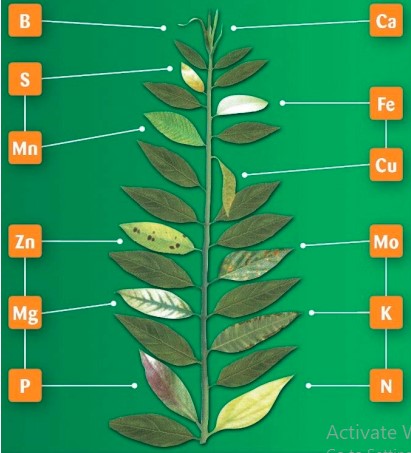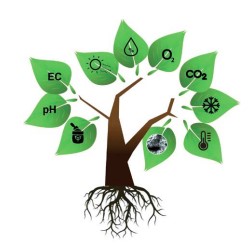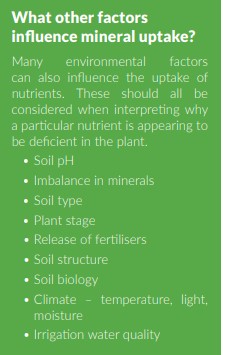In the second part of Direct Driller’s series exploring sap analysis, Mike Abram finds out about the science behind
nutrient use in plants
Nutrients are vital for life but if they get out of balance it can cause either deficiencies or excesses that restrict plant productivity. Sap analysis is a tool to help growers understand the nutrient status of plants at the time of sampling and can highlight potential problems earlier than waiting for visual symptoms. Understanding nutrient status requires knowledge of how mobile they are within the plant. One of the unique things about sap analysis developed by companies like NovaCropControl and more recently offered by Eurofins is that it compares sap from old and new leaves.
Once inside the plant nutrients are transported to where they are needed, typically the plant’s growing point, explains Eric Hegger, a consultant with NovaCropControl.
But some elements in the plant are mobile, while others are immobile. The immobile ones get locked in place and do not move around, while the mobile ones can move from their original location in the plant to areas of greater demand – e.g.: the growing point. That means deficiencies will show up first in different leaf layers depending on nutrient mobility, says Mr Hegger. “For the mobile elements, nitrogen, potassium, magnesium and phosphorus, deficiency will always show up first in the old leaves.
“At the moment there is not enough uptake of these elements, the young leaves will take them from the older parts. If you look at plant sap analysis in this case you will see that young leaves stay high enough, but the old leaves start to drop down, which eventually gets to a deficiency level. Only analysing the middle or younger leaves means you won’t see deficiency as quickly.”

The opposite is true for immobile nutrients – deficiencies start to show up first in younger leaves as the plant can’t remobilise reserves in older leaves. For the medium immobile nutrients either can be true depending on different factors. “That’s why we ask for both young and old leaves as it tells a lot about every element and about nutrient transport. “For example, if it is difficult weather, such as high temperatures or high light intensity and the crop is suffering. In that case plant sap analysis will show levels building in the old leaves because the plant still takes up nutrition, but it can’t be transported to the new leaves as the plant is protecting itself from too much evaporation.”
Nutrient balance and interactions in the plant
The next important factor to understand is that there is competition between some sets of nutrients within the plant. Calcium, potassium, magnesium, sodium and ammonium are all positively charged ions, or cations, while nitrate, chloride, sulphur and phosphate are all negatively charged anions. If the uptake of all the cations is in balance, then the plant’s nutrition is balanced. But when one element’s uptake is higher than the plant needs, that will block the uptake of all the other cations, Mr Hegger says.
“For example, if you have higher uptake of potassium because of an application of manure, that will block the uptake of the other cations.”

So in the sap analysis, if you see potassium is higher than the target values, and calcium is lower it’s probably because of the high potassium rather than inadequate supply of calcium, he explains. Within the cation balance, potassium is usually the element most likely to be too high, although sodium can be too. “Potassium is like candy for plants, and is taken up very easily, whereas the plant finds calcium and magnesium harder to take up and is highly related to a healthy growing crop.” Keeping potassium and calcium in a good balance is important for fruit quality, he notes. Calcium is important for cell strength, while potassium for filling fruits. “If there’s not a good balance that will influence fruit quality.” For example, if the potassium : calcium balance is tipped towards too much potassium that can cause skins to split, whereas too much calcium is responsible for gold flecking on tomatoes.

Comparing the balance between the cations is important for understanding nutrient balance within the plant, and which nutrient to focus on. “One of the common mistakes is focusing on elements that are too low in the plant or soil, whereas it might be that element is being blocked by another one and that’s what you need to focus on, and it won’t matter how much you apply.” Anions work the same way. Too high chloride, for example, could block nitrate uptake, while there are similar interactions for some trace elements, especially iron, manganese, zinc and to a lesser extent copper. “Manganese can easily be too high in a plant and block the uptake of iron and zinc.”
Just to complicate the picture a bit more, there are more interactions between elements beyond just within those groups, as detailed in Mulder’s Chart.
“For example, just looking at calcium, that sulphur, manganese, nitrogen, phosphorus, boron, iron and zinc influence calcium uptake. “Sometimes you could compare the analysis with dominoes – if one element is too low, there’s a good chance it will influence all the other elements as well.” But while that can complicate the picture, Mr Hegger stresses that looking at the cation and to a lesser extent the anion balance is the crucial starting point.
“In 80-85% of cases looking at the cation balance will be enough. Focusing on this will help get the plant in better shape.” If the plant doesn’t respond favourably to changes in management, that’s when digging deeper might be required, he concludes.

How are the target values for each nutrient calculated?
For each nutrient in each crop NovaCropControl has a target range for sap analysis. These are calculated from analysis of at least 500 samples from different fields and growers, Mr Hegger says.
“It’s not an average – we have a special programme working out these values based on median values, but it’s important we have over 500 samples.”
Optimum values are checked regularly, and can change, especially if growers routinely applying too much of a nutrient to a crop. One example was phosphorus in tomatoes where trials by NovaCropControl showed that lower levels than being routinely applied were better for the plant and other nutrient uptake, and the target values were updated.
The same applies for nitrate, Mr Hegger suggests. “We see in the data that nitrate applied could be much lower without effecting the growth of the plant or production. “Very high nitrate can influence other nutrient uptake, and if you have better balance with the nitrate, the other elements are in better balance.”
